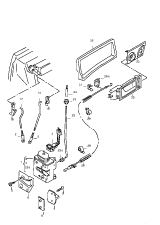By now, the fact that disk drives fail a lot more than the vendors say they should, and for different reasons than we used to think, should be old news. However, it’s been on my mind a lot lately, as in the last three months I’ve lost two drives, and a third is starting to fail. Coincidentally, all three are Maxtor DiamondMax 10 drives, one 150 GB and two 300 GB, all SATA150. They are all well within their design life (and warranty); they have all operated well within their environmental limits; there is no reason why three out of the six Maxtor drives I have should fail in such rapid succession, while all my Western Digital drives – some of them twice as old – are fine. In fact, I’ve never lost a Western Digital drive; on the other hand, all the IBM drives I’ve had are toast, as is the only Seagate I ever bought, a Barracuda that was pretty much DOA, though I misidentified the problem and let the disk lie on a shelf while the warranty ran out. Continue reading “On the longevity of hard drives”
Author: Dag-Erling Smørgrav
Dead Disk Update
In the end, I only lost two sectors: one in the middle of an ISO file in my home directory, another somewhere in my DocumentRoot. Both files were easily recoverable. The affected file systems are now safely parked on a mirror while I get the new array up and running.
ZFS proved uncooperative at first: I had trouble getting a consistent and up-to-date set of patches, and every time I tried to create a file system and copy data over, it would panic. Pawel and I tracked it down to zfs_reclaim(), and finally figured out that it was caused by zfs_reclaim() calling vdropl() directly instead of vdrop(). The thing is that vdropl() is actually private to vfs_subr.c, and declared static; the code just happened to build and work because ZFS was being built with most warnings turned off, and most testers didn’t set CPUTYPE. Giving vdropl() external linkage and a prototype in vnode.h put an end to the kernel panics.
Oh, and by the way, bunnies are cute.
Daylight Saving Time is upon us
Or, as I like to call it, “let’s prove bureaucracy trumps sanity time”.
Come on, what do you think DST is really for? Conserving energy? Think about it: if DST truly has a positive effect on energy consumption, why don’t we have it all year round? DST does not reduce overall energy usage; it just shifts some of it from evening to morning. A recent study found that the overall effect is zero at best and negative at worst.
Do you think DST helps farmers get more work done? On the contrary. A farmer’s schedule is set by the sun, not by the clock. Cows need to be milked at the same time every day, regardless of what the clock says. Dew doesn’t evaporate an hour earlier during DST just to accomodate us. As a result, farmers are out of sync with the rest of society six months out of twelve. Let’s hope they all have Tivo. Continue reading “Daylight Saving Time is upon us”
What we have here is a lack of redundancy
What kind of idiot stores his home directory and his entire web content on a striped set of four disks, with no redundancy?
Me, that’s who. You’d think I would have learned from January’s fiasco that disk crashes don’t just happen to other people. But back in January, I was (relatively) lucky, as the disk that crashed was part of a mirrored set. Not so this time.
The file server actually crashes when trying to read from the faulty disk, so I had to get creative and figure out a way of not only copying it to a healthy disk over the network, but doing so in a way that allows me to recover from crashes and continue where I left off. The result is ndr, the Network-assisted Disk Recovery tool. Continue reading “What we have here is a lack of redundancy”
Lock, stock and barrel
 Spent a couple of hours out in the cold dismantling and reassembling the front passenger side door, which wouldn’t open from the inside. It was also damned hard to close from the outside, as the door latch wouldn’t spring back into position. Turns out the Bowden cable from the inner door handle had slipped, and the door latch retaining spring is actually mounted on the cable.
Spent a couple of hours out in the cold dismantling and reassembling the front passenger side door, which wouldn’t open from the inside. It was also damned hard to close from the outside, as the door latch wouldn’t spring back into position. Turns out the Bowden cable from the inner door handle had slipped, and the door latch retaining spring is actually mounted on the cable.
Unfortunately, I yanked a little too hard on the locking rod, and it broke out of the clip that connects it to the locking mechanism. Luckily, these clips are fairly cheap…
The electrical mirror adjustment didn’t work after reassembly—most likely the electrical connector just needs cleaning. I’ll take care of it when I take the door apart again to change the locking rod clip—preferably on a warm, sunny day…